- NLI Research Institute >
- Prospects for Facility Management Services -Reducing Office Costs and Improving Efficiency-
Prospects for Facility Management Services -Reducing Office Costs and Improving Efficiency-
Naoko Nonoyama
Font size
- S
- M
- L
1. Facility Management Defined
In addition to people, things, money, and information, there is a fifth management resource−facility. Facility management (FM) has recently gained attention to comprehensively plan and manage facilities from a managerial perspective.
The concept of facility management originated in the U.S. and spread widely during the 1980s in Europe and the U.S. Originally centered around functions such as cleaning, maintenance, and security, it developed into a strategic management method also known as "B to B" (boiler man to boardroom).
The objectives of facility management include designing facilities for efficient use, optimizing facility operating cost, and improving job satisfaction of employees. It differs from simply managing properties or introducing office automation in that it is not limited to the maintenance of individual facilities, but instead takes a comprehensive perspective ranging from the use of space and facilities of multiple buildings to managing their asset value (Table 1).

(2) Wide Range of Services
A movement has developed to provide a range of business services based on the FM concept.
Facility management services are metropolitan-type services geared for large office concentrations. More specifically, the broad range of services include cleaning and security services, engineering functions such as space management, layout design, and environmental control, as well as strategic functions such as consulting on asset management, financial valuation, and productivity improvement.
In particular, amid the ongoing advances in information technology, information systems support is also an active area, including the introduction of property management systems and actual building operating management systems.
Given the wide range of services and fuzzy market boundaries, the size of the facility management market is difficult to ascertain. However, since the building maintenance segment alone is almost a ¥3 trillion market, the facility management market is quite substantial. With many businesses recently organizing as service providers, and the market is expected to grow further.
2. Cost Reduction Merit
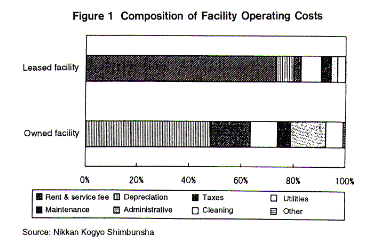
An industry rule of thumb is for office cost to be no more than 10 percent of total cost, and 3 percent of sales (unless sales are in a growth period). However, awareness of office cost has been low because present accounting methods divide facility-related costs into several categories, making them difficult to grasp at a glance. However, office costs are to large to ignore-one large company calculates that fiscal-year-end personnel transfers, which involve 2,000 employees, cost approximately 400 million yen (200,000 yen per person).
In actually implementing facility management to reduce costs, several methods can be used including: (1) increasing the efficiency of facilities, (2) using space more efficiently, and (3) reducing the cost of services through outsourcing. Facility management is especially effective in areas such as facility and space use because cost reductions are easy to grasp.
Other results, while more difficult to measure, include improvements in the office environment and community. The result is that the office becomes a better place to work, raising productivity. Moreover, if comprehensive management is introduced to redesign work flow, set office standards, supervise equipment, and manage fixed assets, further improvements will emerge in management efficiency.
3. Status of Facility Managemen
The facility management concept came to Japan in the mid 1980s. While early attempts were rudimentary and consisted of facility maintenance, full-fledged implementation increased as the concept gradually spread (Table 2). One large company consolidated 12 office locations into two, and succeeded in reducing office costs by 300 million yen per year while expanding the total floor space and improving the office environment.
The need to introduce facility management tends to increase sharply when building a new office or moving an existing one. This is because the task of moving desks, telephones, information equipment and other office items requires that electrical, air-conditioning, security, and other factors be considered together. Moreover, the office design must also consider work flow, document flow, and movement of people.
(2) Status of Providers
Although there are few companies in Japan that provide comprehensive facility management services, a variety of companies provide individual services. In other words, these specialized companies have formed niche markets.
Presently, the market is led by industries that already have a close relationship with facilities such as general contractors, facility service companies (who offer clear-cut energy savings and cost reduction), building maintenance companies (who manage and operate buildings), and office furniture makers (who are strong in office interiors). In the future, entry is expected by information equipment makers, data systems companies, security companies, and real estate management companies.
(3) Slow Implementation of FM
In conducting facility management, it is imperative to have a grasp of factors such as the floor space being managed or leased and facility operating expenses. However, Japanese companies often manage space by division or location, and few companies have an integrated, company-wide system.
According to a survey by JFMA, while 67 percent of Japanese companies have data on their office floor space, over 70 percent of these companies have management systems that are organized along regional or business lines, leaving only 13 percent with a unified company-wide management system. The lack of relevant data is thus considerable compared to foreign companies. The immaturity of management systems is seen as an obstacle to the growth of facility management.
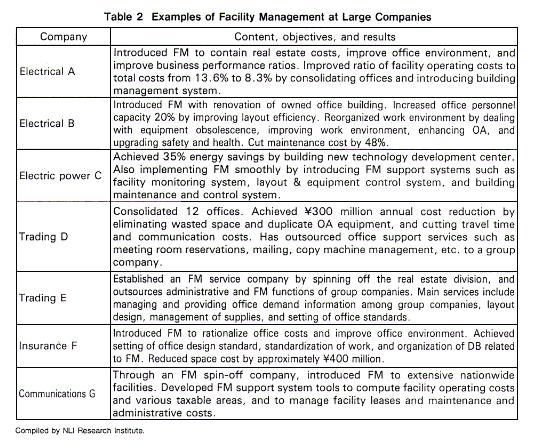
(4) Penetration of FM Outsourcing in the West
In the West, many companies have successfully introduced facility management on a large scale and reduced office costs by 30 to 50 percent. As for service providers, Europe in particular has several companies that specialize in providing comprehensive FM services including FM operations, consulting, and project management (Table 3).
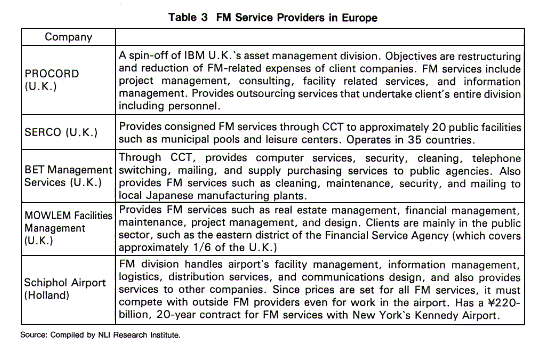
One factor behind the widespread use of facility management has been the penetration of outsourcing practices, which seek to use external resources for greater efficiency. According to a survey by the American Management Association (AMA), U.S. companies outsource much of their FM-related operation, in some cases all of it, to service providers (Figure 2).
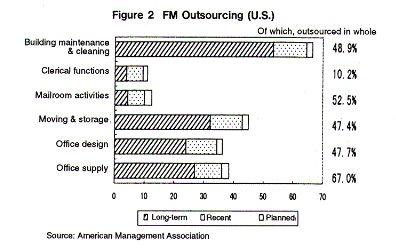
4. Prospects
In the U.S., a new business field called ESCO (energy service company) has gained attention. The ESCO diagnoses a building's energy usage, and is paid a fee based on the amount that energy costs are reduced. The market is estimated to have grown to 100 to 200 billion yen in size.
(1) FM and Changes in the Business Environment
With Japanese companies earnestly pursuing cost reduction following the collapse of the bubble economy, a foundation is forming for the penetration of facility management. Restructuring and reengineering personnel cutbacks and organizational changes are raising the need for reevaluating office space. In addition, the collapse of the land price myth and management focused on return on equity, emphasis on the effective and efficient use of real estate. To pursue a management innovation, there is a growing need to restrain investment and construct offices suited to the particular work or process at appropriate prices.
In particular, as information technology advances, companies will need to introduce information equipment and construct LANs. Facility management services will benefit from the resulting changes in work flow and demand for expertise in building more efficient and flexible networks
Demand for facility management services will also come from indirect factors such as enhancement of security, concern over earthquake resistance, aging of employees and increase in female employees, and growing techno-stress.
(2) Supply and Demand Factors Affecting FM Development
In addition to the background changes mentioned above, below we consider demand and supply side factors that will support the development of facility management services in the future.
1. Demand Side Factors
a) Expansion of remodeling market
Office remodeling is a major cause behind the introduction of facility management. Despite sluggishness in overall construction volume, the remodeling market was propelled by an increase in construction stock and advances in information technology to post 4.2 percent annual growth from 1990 to 1995, compared to only 1.6 percent for new construction.
According to a survey by NLI Research Institute, in the Tokyo 23-ward area alone, 55 high-rise buildings are old enough to be candidates for office remodeling, amounting to 3.8 million square meters.
b) Easing of Skeleton Leasing Standards
Easing of the construction standards law in March 1997 has enabled "skeleton leasing," in which offices can be leased before the interior is finished. In the usual method, because the building owner finishes the interior before leasing, tenants are sometimes forced to remodel the interior to suit their needs, and are also obligated to restore the interior's original condition upon leaving. However, with skeleton leasing, tenants will be able to design the interior as they wish, thus stimulating demand for facility management services.
c) Market expansion to non-office facilities
The facility management market is spreading beyond offices to educational, medical, research and other facilities. Thus the potential market is huge. For example, there are signs that medical facilities are dividing medical functions from business functions. With hospital managements expected to further emphasize cost reductions in the future, facility management will attract greater attention.
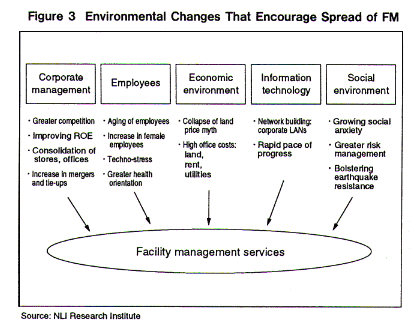
2. Supply Side Factors
a) Advanced and more comprehensive services
On the supply side, facility management services are expected to become more advanced and comprehensive. If FM companies provide total services as in the U.S. and Europe-including asset and facility strategy building and portfolio planning, consulting for outsourcing evaluation, and facility-related project management-they will offer users added value and enhanced efficiency, while also improving their own profit margins.
b) Possibility of outsourcing
Outsourcing, a practice which has recently been penetrating into Japan, is a promising area for FM. Outsourcing has been common in facility management because companies find it easy to distinguish this area as a non-core business.
However, due to employment considerations, outsourcing is not likely to be as drastic as in the West, where companies commonly eliminate entire divisions. Still, outsourcing of FM services can be expected to grow in the public sector, such as in the operation of public museums and libraries.
(3) Future Trends
As stated earlier, the difficulty of knowing comprehensive facility costs due to indirect factors such as accounting practices, and strong resistance to disclosing the cost if known, are barriers to the penetration of facility management. Another persistent obstacle is the typically Japanese notion that comfortable offices are an extravagance.
Nonetheless, we predict that facility management services will grow gradually along the following lines.
1. Specialization by Area
For the foreseeable future, the facility management services market will be comprised of many specialized niche service providers. However, since users may find that using a different provider for each facet of business may increase costs, the market needs to be an appropriate competitive environment for services and prices. for growth
2. Spin-offs that provide comprehensive services
One likely source of new entrants are spin-offs of facility management divisions of large companies. As these spin-offs gradually acquire outside customers, they can grow to become independent providers of comprehensive services. In that case, the leading candidates are companies that own many facilities across the country. Another possibility is for users that have achieved efficiency by incorporating facility management to use their expertise to become independent providers.
More time is needed for the emergence of businesses that provide the type of advanced services seen in the West. These businesses will cause the facility management services market to grow further.
Naoko Nonoyama
Research field
レポート紹介
-
研究領域
-
経済
-
金融・為替
-
資産運用・資産形成
-
年金
-
社会保障制度
-
保険
-
不動産
-
経営・ビジネス
-
暮らし
-
ジェロントロジー(高齢社会総合研究)
-
医療・介護・健康・ヘルスケア
-
政策提言
-
-
注目テーマ・キーワード
-
統計・指標・重要イベント
-
媒体
- アクセスランキング

















